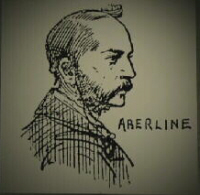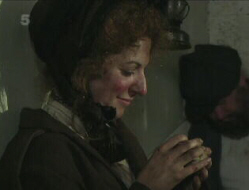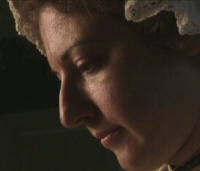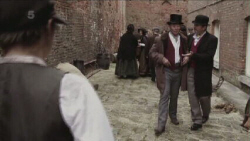Mary-Anne Nichols
The savagery of the Killings Worsens
Whitechapel in 1888 was a slum landscape full of decaying buildings with a population of largely poor and destitute people whose only home was a bed
in a common lodging house or if they were lucky, a room in which the whole family could live.

Frederick Aberline
Using computer-generated imagery and drawing upon contemporary maps, plans and other documents we can see this cramped area as it was then, a dense
confined warren of narrow streets where two unsolved murders had already been committed. Jack the Ripper was about to strike.
But, reconstructing the street as it looked then Buck's Row is revealed as a short narrow road occupied on one side by a row of workmen's cottages
and on the other by large warehouses. Yet, seeing this simple layout as it was then is vital to understanding how the Ripper committed his crimes.
At 20 to 4 in the morning Charles Cross was walking to work along Buck's Row when he saw something on the ground against the gates and went to
investigate with another passer-by Robert Paul.
Ralph Llewellyn
Soon after, PC John Neill entered Buck's Row on his beat, he saw the body on the ground. The woman who gazed back with sightless eyes had had her
throat cut twice, one of the cuts went down to the spine, but what Neill didn't realise was that the woman had been hideously mutilated. The police
summoned Dr Ralph Llewellyn whose surgery and residence was nearby. He was not required to do more than decided whether the person was dead or alive
and the police hurried to have the body removed.

Mary-Ann Nichols
In the mortuary, the body was stripped by two attendants and it was discovered that the woman had been disembowelled Dr Llewellyn was immediately
summoned and this time he made a thorough examination. Later describing the woman's injuries in his testimony at the inquest "Two or 3 inches in on
the left side there was a wound running in a ragged manner, this wound was a very deep. There were three or four similar cuts running down wards
along the right side all of these wounds had been inflicted by a knife, used violently and downwards."
He's not just stabbing he's mutilating by opening up the genital area and then hacking inside the rip that he's made.
Dr Llewellyn was of the opinion that the woman had been murdered where she lay and that most of her blood had soaked into her clothes. The newspaper's
interest in what had been previously seen as a local story now climbed to a new level and Scotland Yard took charge of the investigation sending in one
of their top officers Inspector Frederick Aberline. Aberline was a hugely popular and respected Inspector.

Polly
The victim was eventually identified as Mary-Ann Nichols known to everyone as Polly. She'd started life as a servant before marrying William
Nichols and having children. In 1888 life offered women few choices when a marriage went wrong. For Polly Nichols that meant she had no alternative,
after leaving the marital home, but to spend the next seven years drifting from workhouse to workhouse. According to the newspapers, things got so
bad that she ended up sleeping rough in Trafalgar Square over the winter of 1887 joining the hundreds of other homeless people who dossed there
every night.
That same winter, Trafalgar Square would become the focus of the notorious Bloody Sunday Riots when the Commissioner of the Metropolitan police
Sir Charles Warren deployed armed troops to violently suppress the demonstrators.
Unscathed, Polly managed to find work as a domestic servant in Wandsworth and April 1888 she wrote a letter to her father advising of four new
situation. Polly had been caught stealing from her employers and had absconded to the East End. Polly took lodgings in Thrall Street in the heart
of a district known for its common lodgings and doss houses where thousands of poor and homeless people could have a bed for just 4d a night. But,
they had a fearful reputation as hotbeds for crime and immorality.
Despite her troubles, Polly had somehow managed to preserve her looks. She was 43 years old and had some teeth missing, but the press reported
that she appeared to be 10 years younger. In the final hours of the 30 August she was found in the kitchen of her Thrall Street lodging house. She
had no money to pay for her lodgings and was put out in the street. An hour later, one of Polly's friends, Emily Holland, bumped into her and
Osborne Street. Polly walked eastwards towards the main road, it was the last time she was seen alive.

Seeing the streets as they would have looked then, it becomes clear that the murderer must have taken a considerable risk. Although the street
was dark, there were streetlights near where the body was found, and people lived in the neighbouring cottages. Harriet Lily who lived at number seven
Buck's Row was awakened by a noisy goods train passing on the nearby railway line and as the noise quietened she heard some moanings and gasps in
the street followed by whispering but no other nearby residents heard anything.
Mrs Emma Green, who lived near the murder site was typical in hearing nothing. The authorities had managed to identify the victim but they'd
achieved a little else. In the face of growing opinion that the Whitechapel killings had to be connected the police had been utterly unable to suggest
a motive and were still clinging to the idea that they were gang related.
The Ripper murders, as they would be known by the world for the next 120 years, had begun.
With the murder of Polly Nichols it was realised there was a very unusual murderer at large.



